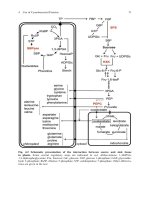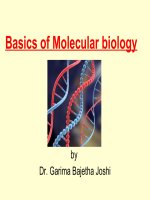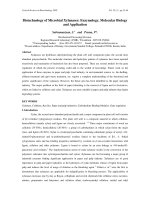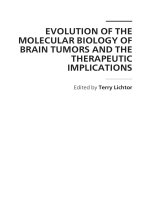molecular biology primer
Bạn đang xem bản rút gọn của tài liệu. Xem và tải ngay bản đầy đủ của tài liệu tại đây (7.78 MB, 271 trang )
www.bioalgorithms.infoAn Introduction to Bioinformatics Algorithms
Angela Brooks, Raymond Brown, Calvin Chen, Mike Daly,
Hoa Dinh, Erinn Hama, Robert Hinman, Julio Ng, Michael
Sneddon, Hoa Troung, Jerry Wang, Che Fung Yung
An Introduction to Bioinformatics Algorithms www.bioalgorithms.info
Outline:
•
0. History: Major Events in Molecular Biology
•
1. What Is Life Made Of?
•
2. What Is Genetic Material?
•
3. What Do Genes Do?
•
4. What Molecule Code For Genes?
•
5. What Is the Structure Of DNA?
•
6. What Carries Information between DNA and Proteins
•
7. How are Proteins Made?
An Introduction to Bioinformatics Algorithms www.bioalgorithms.info
Outline Cont.
•
8. How Can We Analyze DNA
•
1. Copying DNA
•
2. Cutting and Pasting DNA
•
3. Measuring DNA Length
•
4. Probing DNA
•
9. How Do Individuals of a Species Differ
•
10. How Do Different Species Differ
•
1. Molecular Evolution
•
2. Comparative Genomics
•
3. Genome Rearrangement
•
11. Why Bioinformatics?
An Introduction to Bioinformatics Algorithms www.bioalgorithms.info
•
Microscopic biology began in
1665
•
Robert Hooke (1635-1703)
discovered organisms are made
up of cells
•
Matthias Schleiden (1804-
1881) and Theodor Schwann
(1810-1882) further expanded
the study of cells in 1830s
•
Robert
Hooke
•
Theodor
Schwann
•
Matthias
Schleiden
An Introduction to Bioinformatics Algorithms www.bioalgorithms.info
Major events in the history of
Molecular Biology 1800 - 1870
•
1865 Gregor Mendel discover
the basic rules of heredity of
garden pea.
•
An individual organism has two
alternative heredity units for a
given trait (dominant trait v.s.
recessive trait)
•
1869 Johann Friedrich
Miescher discovered DNA and
named it nuclein.
Mendel: The Father of Genetics
Johann Miescher
An Introduction to Bioinformatics Algorithms www.bioalgorithms.info
Major events in the history of
Molecular Biology 1880 - 1900
•
1881 Edward Zacharias showed chromosomes are composed
of nuclein.
•
1899 Richard Altmann renamed nuclein to nucleic acid.
•
By 1900, chemical structures of all 20 amino acids had
•
been identified
An Introduction to Bioinformatics Algorithms www.bioalgorithms.info
Major events in the history of
Molecular Biology 1900-1911
•
1902 - Emil Hermann Fischer wins Nobel prize:
showed amino acids are linked and form proteins
•
Postulated: protein properties are defined by amino
acid composition and arrangement, which we
nowadays know as fact
•
1911 – Thomas Hunt Morgan discovers genes on
chromosomes are the discrete units of heredity
•
1911 Pheobus Aaron Theodore Lerene discovers
RNA
Emil
Fischer
Thomas
Morgan
An Introduction to Bioinformatics Algorithms www.bioalgorithms.info
Major events in the history of
Molecular Biology 1940 - 1950
•
1941 – George Beadle and Edward
Tatum identify that genes make
proteins
•
1950 – Edwin Chargaff find
Cytosine complements Guanine and
Adenine complements Thymine
George
Beadle
Edward
Tatum
Edwin
Chargaff
An Introduction to Bioinformatics Algorithms www.bioalgorithms.info
Major events in the history of
Molecular Biology 1950 - 1952
•
1950s – Mahlon Bush Hoagland
first to isolate tRNA
•
1952 – Alfred Hershey and
Martha Chase make genes from
DNA
Mahlon Hoagland
Hershey Chase Experiment
An Introduction to Bioinformatics Algorithms www.bioalgorithms.info
Major events in the history of
Molecular Biology 1952 - 1960
•
1952-1953 James D. Watson
and Francis H. C. Crick
deduced the double helical
structure of DNA
•
1956 George Emil Palade
showed the site of enzymes
manufacturing in the
cytoplasm is made on RNA
organelles called ribosomes.
James Watson
and Francis Crick
George Emil Palade
An Introduction to Bioinformatics Algorithms www.bioalgorithms.info
Major events in the history of
Molecular Biology 1970
•
1970 Howard Temin and David
Baltimore independently isolate
the first restriction enzyme
•
DNA can be cut into reproducible pieces
with site-specific endonuclease called
restriction enzymes;
•
the pieces can be linked to
bacterial vectors and introduced
into bacterial hosts. (gene cloning
or recombinant DNA technology)
An Introduction to Bioinformatics Algorithms www.bioalgorithms.info
Major events in the history of
Molecular Biology 1970- 1977
•
1977 Phillip Sharp and
Richard Roberts demonstrated
that pre-mRNA is processed by
the excision of introns and
exons are spliced together.
•
Joan Steitz determined that the
5’ end of snRNA is partially
complementary to the
consensus sequence of 5’ splice
junctions.
Joan Steitz
Phillip Sharp
Richard Roberts
An Introduction to Bioinformatics Algorithms www.bioalgorithms.info
Major events in the history of
Molecular Biology 1986 - 1995
•
1986 Leroy Hood: Developed
automated sequencing mechanism
•
1986 Human Genome Initiative
announced
•
1990 The 15 year Human Genome
project is launched by congress
•
1995 Moderate-resolution maps of
chromosomes 3, 11, 12, and 22
maps published (These maps
provide the locations of “markers”
on each chromosome to make
locating genes easier)
Leroy Hood
An Introduction to Bioinformatics Algorithms www.bioalgorithms.info
Major events in the history of
Molecular Biology 1995-1996
•
1995 John Craig Venter: First
bactierial genomes sequenced
•
1995 Automated fluorescent
sequencing instruments and
robotic operations
•
1996 First eukaryotic genome-
yeast-sequenced
John Craig Venter
An Introduction to Bioinformatics Algorithms www.bioalgorithms.info
•
1997 E. Coli sequenced
•
1998 PerkinsElmer, Inc Developed 96-capillary
sequencer
•
1998 Complete sequence of the Caenorhabditis elegans
genome
•
1999 First human chromosome (number 22) sequenced
Major events in the history of
Molecular Biology 1997 - 1999
An Introduction to Bioinformatics Algorithms www.bioalgorithms.info
Major events in the history of
Molecular Biology 2000-2001
•
2000 Complete sequence of
the euchromatic portion of
the Drosophila melanogaster
genome
•
2001 International Human
Genome Sequencing:first
draft of the sequence of the
human genome published
An Introduction to Bioinformatics Algorithms www.bioalgorithms.info
Major events in the history of
Molecular Biology 2003- Present
•
April 2003 Human Genome
Project Completed. Mouse
genome is sequenced.
•
April 2004 Rat genome
sequenced.
An Introduction to Bioinformatics Algorithms www.bioalgorithms.info
An Introduction to Bioinformatics Algorithms www.bioalgorithms.info
Outline For Section 1:
•
All living things are made of Cells
•
Prokaryote, Eukaryote
•
Cell Signaling
•
What is Inside the cell: From DNA, to RNA, to Proteins
An Introduction to Bioinformatics Algorithms www.bioalgorithms.info
Cells
•
Fundamental working units of every living system.
•
Every organism is composed of one of two
radically different types of cells:
prokaryotic cells or
eukaryotic cells.
•
Prokaryotes and Eukaryotes are descended from the same primitive cell.
•
All extant prokaryotic and eukaryotic cells are the result of a total
of 3.5 billion years of evolution.
An Introduction to Bioinformatics Algorithms www.bioalgorithms.info
Cells
•
Chemical composition-by weight
•
70% water
•
7% small molecules
•
salts
•
Lipids
•
amino acids
•
nucleotides
•
23% macromolecules
•
Proteins
•
Polysaccharides
•
lipids
•
biochemical (metabolic) pathways
•
translation of mRNA into proteins
An Introduction to Bioinformatics Algorithms www.bioalgorithms.info
•
A cell is a smallest structural unit of an
organism that is capable of independent
functioning
•
All cells have some common features
An Introduction to Bioinformatics Algorithms www.bioalgorithms.info
!
•
Born, eat, replicate, and die
An Introduction to Bioinformatics Algorithms www.bioalgorithms.info
2 types of cells: Prokaryotes
v.s.Eukaryotes
An Introduction to Bioinformatics Algorithms www.bioalgorithms.info
"#"
•
According to the most recent evidence, there are three main branches to the tree of life.
•
Prokaryotes include Archaea (“ancient ones”) and bacteria.
•
Eukaryotes are kingdom Eukarya and includes plants, animals, fungi and certain algae.









